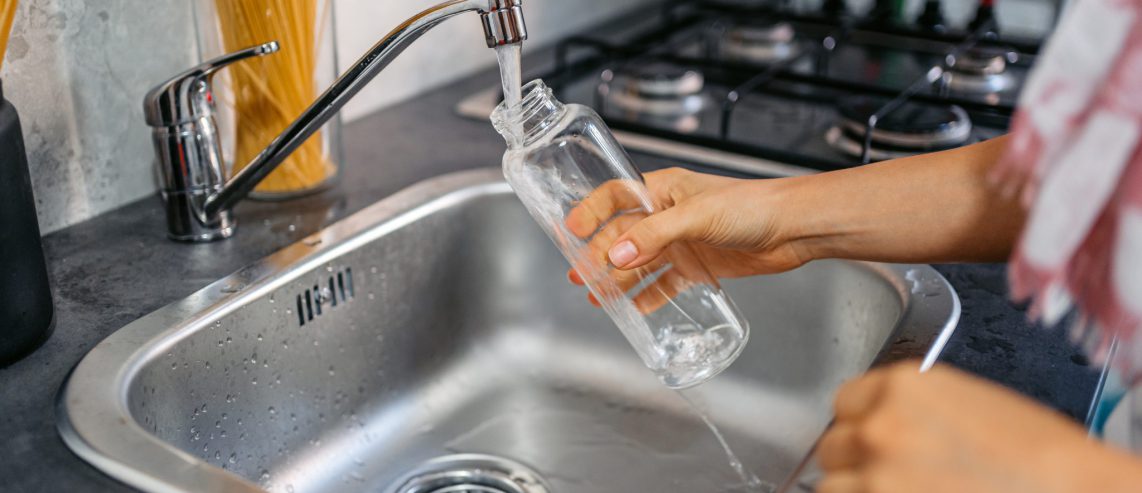Water is essential to our daily lives, and staying hydrated is crucial for maintaining good health. Many people carry water bottles with them to have access to clean water wherever they go. It’s a convenient option that may be more environmentally friendly than disposable plastic water bottles.
You might not realize that your reusable water bottle could harbor harmful bacteria, mold, and fungi. If you’re frequently using a water bottle, tumbler, or thermos, it’s important to understand the risks of a dirty bottle and the steps you can take to keep it clean.
Improperly cleaned water bottles can increase the risk of foodborne illness. Older adults, young children, and immunocompromised people may be at particular risk if they drink from dirty water bottles.
Never Miss a Beat!
Subscribe to Our HealthBeat Newsletter!
Thank you for subscribing!
You can now select the specific newsletters you'd like to receive.
You are already subscribed.
Subscribe to more newsletters in our email preference center.
Sorry, an error occurred. Please try again later.
Get Healthy Tips Sent to Your Phone!
Health Risks of Dirty Water Bottles
Used and unwashed water bottles can pose serious risks to your health, including gastrointestinal illness and food poisoning-like symptoms, according to the International Association for Food Protection.
While you probably refill your water bottle throughout the day, you ideally should clean your bottle and all its parts after every use or at least once a day.
Bacterial contamination:
Dirty water bottles can become breeding grounds for harmful bacteria like E. coli, Salmonella, and Staphylococcus aureus. These bacteria can cause illnesses, including gastrointestinal infections, food poisoning, and even skin infections, according to the Food and Drug Administration.
Bacteria thrive in moist environments, and when we drink from our water bottles without washing them, we introduce bacteria into our bodies, putting our health at risk.
Mold and fungi growth:
When water bottles are not properly cleaned, they can become a haven for mold and fungi growth. These microorganisms can trigger allergic reactions and respiratory problems, particularly in individuals with allergies or compromised immune systems.
Mold and fungi love damp and dark environments, making your water bottle an ideal breeding ground if not cleaned regularly.
Foul odors and tastes
A dirty water bottle can develop unpleasant odors and tastes over time. Bacteria and mold can contribute to these issues, making it more difficult to drink from your bottle.
How to Properly Clean Your Water Bottle
If a reusable water bottle is a part of your daily routine, it is important to rinse and clean it regularly. Of course, reuseable water bottles come in different shapes, sizes, and materials — and some are more difficult to clean than others.
First, review your bottle’s manufacturer guidelines for tips on proper cleaning. For example, some water bottles can be placed in the dishwasher, but many popular aluminum bottles cannot. These bottles tend to be coated in a protective lining that will break down in a dishwasher.
Many bottles contain smaller parts that may need to be disassembled before washing. Some bottles have a wider mouth for easier cleaning. Others may have an opening that is only an inch or so in diameter —making it more challenging to clean inside.
In addition to hot water and dish soap, consider using a small bottle brush to cleanse your bottle thoroughly.
Rinse after use:
- After each use, rinse your water bottle with hot water to remove any residual liquids. This will help prevent the build-up of bacteria and other contaminants.
- If possible, use a brush with a long handle or a bottle brush to reach the bottom and sides of your bottle, ensuring a thorough clean.
Use soap and warm water:
- To remove any remaining dirt or bacteria, wash your water bottle with soap and warm water. Choose a mild dishwashing detergent or a bottle-cleaning solution specifically designed for reusable bottles.
- Gently scrub the inside and outside of your bottle, paying special attention to the mouthpiece and lid.
- Many aluminum bottles must be hand-washed, so check your manufacturer’s guidelines.
Don’t forget about the straw:
- Straws can be particularly challenging to clean. First, disassemble the pieces of your water bottle, including your straw. Submerge the straw in hot, soapy water. You may want to let it soak for a few moments.
- Try using a straw brush (sometimes referred to as a tube brush, pipe brush, or small bottle brush) to clean the inside of your straw.
- If you don’t have a brush, add a tiny drop of soap to one end of the straw and run a bit of water through it. Use your fingers to squeeze the straw, rinsing out the water and any debris.
- After cleaning your straw with soap and water, you may be able to sterilize it by boiling it in hot water. Stainless steel and silicone straws, for example, can be boiled.
Rinse and air dry:
- After washing, rinse your water bottle thoroughly with clean water to remove any soap residue. Soap left behind can affect the taste of your water and may also be harmful if ingested.
- Allow your water bottle to air dry completely before reusing or storing it. Leaving it open helps prevent the growth of mold and bacteria.
Tips for Maintaining Cleanliness and Hygiene
First, be sure to clean your water bottle daily.
- Make it a habit to clean your water bottle daily, especially if you use it regularly or fill it with liquids other than water.
- Regular cleaning will help prevent the accumulation of bacteria and ensure that your water stays fresh and safe to drink.
Sharing water bottles may also mean sharing illness.
- To minimize the risk of cross-contamination, it is best to avoid sharing your water bottle with others. This is particularly important during flu or cold seasons or if someone is already sick.
Over time, consider replacing your reusable water bottle.
- Many reusable water bottle brands sell their products with lifetime warranties. However, reusable water bottles can break down over time.
- Over time, even with proper cleaning, water bottles can deteriorate and become more difficult to clean thoroughly. Review your bottle manufacturer’s guidelines to see when it might be time to replace your bottle.
Keeping your water bottles clean is essential for safeguarding your health and ensuring the water you consume remains safe and refreshing.
By understanding the dangers of dirty water bottles and following simple cleaning practices, you can maintain hygiene, prevent illness, and enjoy the benefits of staying hydrated. Remember to make cleaning your water bottle a regular part of your routine and stay hydrated with peace of mind.
About UPMC
Headquartered in Pittsburgh, UPMC is a world-renowned health care provider and insurer. We operate 40 hospitals and 800 doctors’ offices and outpatient centers, with locations throughout Pennsylvania, Maryland, New York, West Virginia, and internationally. We employ 4,900 physicians, and we are leaders in clinical care, groundbreaking research, and treatment breakthroughs. U.S. News & World Report consistently ranks UPMC Presbyterian Shadyside as one of the nation’s best hospitals in many specialties and ranks UPMC Children’s Hospital of Pittsburgh on its Honor Roll of America’s Best Children’s Hospitals. We are dedicated to providing Life Changing Medicine to our communities.

